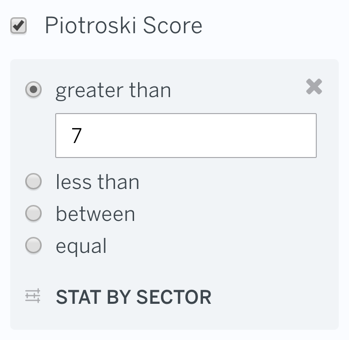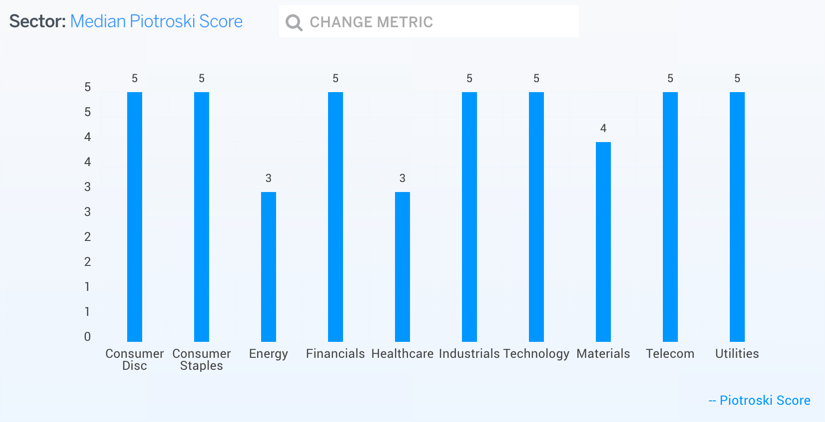Piotroski F-Score Stock Screen
The goal of this screen is to find companies that score an 8 or 9 on the Piotroski F-Score.
You can view the latest results here: Screen: Piotroski Score
About the Piotroski F-Score
Joseph Piotroski, a Stanford accounting professor, developed a set of rules to find companies with healthy Liquid Balance Sheets, Profitability, and Operating Efficiency. Professor Piotroski proposed screening for stocks based on a checklist that awards one point for each matched criterion. In his now famous paper, Professor Piotroski shared the results of a 20-year backtest that showed a 7.5% increase in returns.
I show that the mean return earned by a high book-to-market investor can be increased by at least 7.5% annually through the selection of financially strong high BM firms while the entire distribution of realized returns is shifted to the right. In addition, an investment strategy that buys expected winners and shorts expected losers generates a 23% annual return between 1976 and 1996, and the strategy appears to be robust across time and to controls for alternative investment strategies.-- Value Investing: The Use of Historical Financial Statement Information to Separate Winners from Losers
The criteria he described is as follows:
Liquid Balance Sheet
- Change in
Debt / Total Assets< 0 - Change in
Current Ratio> 0 - Change in
Diluted Shares Outstanding< 0
Profitability
Return on Assets> 0Operating Cash Flow> 0- Change in
Return on Assets> 0 Operating Cash Flow>Net Income
Operating Efficiency
- Change in
Gross Margin> 0 - Change in
Asset Turnover> 0
Criteria Details
Change in Debt / Total Assets < 0
Debt / Total Assets measures how much of the company's assets are financed with debt. This criterion intends to filter out companies that are taking on debt to finance operations because of shortfalls in free cash flow.
Change in Current Ratio > 0
Current Ratio measures whether a firm is capitalized with enough assets to pay its debts over the next twelve months by comparing a firm's Current Assets to its Current Liabilities. This criterion attempts to weed out companies that diluted shareholders.
Change in Diluted Shares Outstanding < 0
Diluted measures the number of shares that would be outstanding if all possible sources of dilution (employee stock options, convertible bonds, etc.) are exercised. This criterion attempts to weed out companies that have decreasing working capital efficiency.
Return on Assets > 0
Return on Assets represents the dollars in Net Income a company generates per dollar of Assets. This criterion filters out companies that are not profitable.
Operating Cash Flow > 0
Operating Cash Flow (OCF) can be found on the Statement of Cash Flows reported by the company. OCF measures the amount of cash generated by a company's normal business operations. No company can operate indefinitely with negative Operating Cash Flow. This criterion filters out companies that need cash on the Balance Sheet or outside cash infusions to operate.
Change in Return on Assets > 0
As described earlier, Return on Assets (ROA) measures profitability. This criterion filters out companies that have negatively trending ROA.
Operating Cash Flow > Net Income
Management is highly motivated to manage Net Income to appease Wall Street. Operating Cash Flow is less susceptible to earnings management. This criterion attempts to filter out companies that may be engaging in this type of manipulation.
Change in Gross Margin > 0
Gross Margin is expressed as a percentage and calculated as follows:

Gross Margin is a strong indicator of pricing power. This criterion intends to weed out companies that may be coming under pricing pressure from competitors.
Change in Asset Turnover > 0
Assert Turnover represents the dollars in revenue a company generates per dollar of assets:
Asset Turnover = Total Revenue / Average Total Assets
Asset Turnover is typically used to gauge the efficiency of a company and its management at deploying capital for assets that generate revenue. This criterion tries to weed out companies that have declining asset efficiency.
Filters
In this section, I'll summarize the key filters used in the default Piotroski Score screen.
Filter 1: Piotroski Score
finbox.io makes it easy to find stocks that meet Professor Piotroski's criteria. You simply need to add the Piotroski Score filter:

To get guidance on selecting a threshold, you can use the STAT BY SECTOR button:

Since the median score in each sector is around 5, a Piotroski Score threshold of > 7 leaves the top results. It's also easy to add additional criteria to trim down the list. The default screen uses Market Capitalization as an additional filter. To learn more about adjusting filters, view Using the Stock Screener!
Filter 2: Market Capitalization
Market Capitalization is a public company's total equity value as implied by the stock's last observed trading price. In this screen, I'm using it to weed out companies that are below a certain size (< $250 million).
Here's the default filter:

Downloading Results
Once the screen returns the relevant matches, you can either research the individual names further or create a portfolio based on the results.
You can also Save the screen run again at a later time or Download all the
matching results:

Sources / Further Reading:
- Wikipedia: Value Investing
- Joseph Piotroski Bio
- Piotroski Backtest
- Explorer: Piotroski Score
- Explorer: Market Cap
- Explorer: Debt
- Explorer: Total Assets
- Explorer: Current Ratio
- Explorer: Return on Assets
- Explorer: Operating Cash Flow
- Explorer: Return on Assets
- Explorer: Net Income
- Explorer: Gross Margin
- Explorer: Asset Turnover

